
The flowerpeckers are a family, Dicaeidae, of passerine birds. The family comprises two genera, Prionochilus and Dicaeum, with 50 species in total. The family has sometimes been included in an enlarged sunbird family Nectariniidae. The berrypeckers of the family Melanocharitidae and the painted berrypeckers, Paramythiidae, were once lumped into this family as well. The family is distributed through tropical southern Asia and Australasia from India east to the Philippines and south to Australia. The family has a wide range occupying a wide range of environments from sea level to montane habitats. Some species, such as the mistletoebird of Australia, are recorded as being highly nomadic over parts of their range.

The Nilgiri flowerpecker is a tiny bird in the flowerpecker family. Formerly a subspecies of what used to be termed as the plain flowerpecker although that name is now reserved for Dicaeum minullum. Like others of the group, it feeds predominantly on nectar and fruits. They forage within the canopy of forests and are found in India. They are non-migratory and the widespread distribution range includes several populations that are non-overlapping and morphologically distinct, some of which are recognized as full species. They are important pollinators and dispersers of mistletoes in forests.
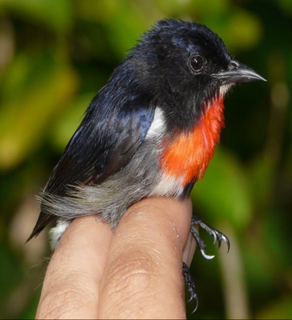
Dicaeum is a genus of birds in the flowerpecker family Dicaeidae, a group of passerines tropical southern Asia and Australasia from India east to the Philippines and south to Australia. The genus Dicaeum is closely related to the genus Prionochilus and forms a monophyletic group.

The thick-billed flowerpecker is a tiny bird in the flowerpecker group. They feed predominantly on fruits and are active birds that are mainly seen in the tops of trees in forests. It is a resident bird with a wide distribution across tropical southern Asia from India east to Indonesia and Timor with several populations recognized as subspecies some of which are sometimes treated as full species.

Legge's flowerpecker or the white-throated flowerpecker, is a small passerine bird. It is an endemic resident breeder in Sri Lanka. It is named after the Australian ornithologist William Vincent Legge.

The olive-crowned flowerpecker is a small passerine bird in the flowerpecker family, Dicaeidae. It is found in far western New Guinea and on adjacent islands.

The yellow-crowned flowerpecker is a species of bird in the family Dicaeidae. It is endemic to Luzon Island in the Philippines. The flame-crowned flowerpecker, which is endemic to Mindanao, was formerly considered conspecific. Its natural habitat is tropical moist montane forest. It is becoming rare due to habitat loss.
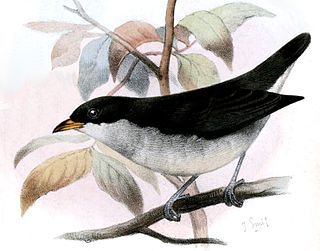
The red-keeled flowerpecker or red-striped flowerpecker is a species of bird in the family Dicaeidae. It is endemic to the Philippines. Its natural habitat is subtropical or tropical moist lowland forests. The black-belted flowerpecker was formerly regarded as a subspecies of this bird.

The grey-sided flowerpecker is a species of bird in the family Dicaeidae. It is endemic to Indonesia. Its natural habitats are subtropical or tropical moist lowland forest and subtropical or tropical moist montane forest.

The yellow-vented flowerpecker is a species of bird in the family Dicaeidae. It is found in Bangladesh, Bhutan, Brunei, Cambodia, China, India, Indonesia, Laos, Malaysia, Myanmar, Nepal, Singapore, Thailand, and Vietnam. Its natural habitats are subtropical or tropical moist lowland forest and subtropical or tropical moist montane forest. Along with D. melanoxanthum, D. agile, and D. everetti, it is often referred to as an “odd” Dicaeum species because of unique characteristics separating it from other species within the family. While most species have vestigial outermost primary feathers, those of the yellow-vented flowerpecker are elongated.
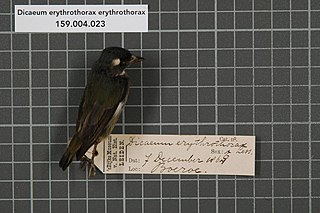
The Buru flowerpecker is a species of bird in the family Dicaeidae. It is endemic to the Maluku Islands in Indonesia. Its natural habitats are subtropical or tropical moist lowland forest and subtropical or tropical moist montane forest. It is restricted to Buru.

The buzzing flowerpecker or white-bellied flowerpecker is a species of bird in the family Dicaeidae. It is endemic to the Philippines. Its natural habitats are subtropical or tropical moist lowland forest and subtropical or tropical moist montane forest.

The blue-cheeked flowerpecker or red-chested flowerpecker is a species of bird in the family Dicaeidae. It is found on the Lesser Sundas. Its natural habitats are subtropical or tropical moist lowland forest and subtropical or tropical moist montane forest.

The yellow-bellied flowerpecker is a species of bird in the flowerpecker family Dicaeidae.

The olive-capped flowerpecker is a species of bird in the family Dicaeidae. It is endemic to the island of Mindanao in the Philippines.Its natural habitat is tropical moist montane forest.

The whiskered flowerpecker is a species of bird in the family Dicaeidae. It is endemic to the island of Mindanao in the Philippines.
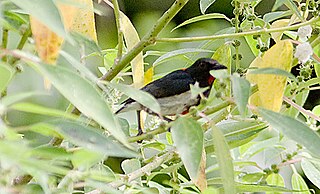
The scarlet-collared flowerpecker is a species of bird in the family Dicaeidae, about 10 cm long and is endemic to the Philippines.
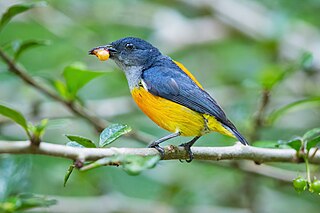
The orange-bellied flowerpecker is a species of bird in the family Dicaeidae. It is found in Bangladesh, Brunei, India, Indonesia, Malaysia, Myanmar, the Philippines, Singapore, and Thailand.

The ashy flowerpecker is a species of bird in the family Dicaeidae. It is endemic to Indonesia where it occurs on Seram, Ambon and nearby islands in the Banda Arc. Its natural habitats are subtropical or tropical moist lowland forest and subtropical or tropical moist montane forest.
The Halmahera flowerpecker is a species of bird in the family Dicaeidae. It is endemic to Halmahera in Indonesia. Its natural habitats are subtropical or tropical moist lowland forest and subtropical or tropical moist montane forest. It was recently considered conspecific with the Buru flowerpecker.




















